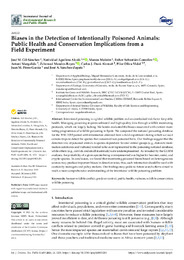Please use this identifier to cite or link to this item:
https://hdl.handle.net/11000/33896Full metadata record
| DC Field | Value | Language |
|---|---|---|
| dc.contributor.author | Gil-Sánchez, José M | - |
| dc.contributor.author | Aguilera-Alcalá, Natividad | - |
| dc.contributor.author | Moleón, Marcos | - |
| dc.contributor.author | Moleón, Marcos | - |
| dc.contributor.author | Margalida, Antoni | - |
| dc.contributor.author | Morales-Reyes, Zebensui | - |
| dc.contributor.author | dura alemañ, carlos javier | - |
| dc.contributor.author | Oliva-Vidal, Pilar | - |
| dc.contributor.author | Pérez-García, Juan M. | - |
| dc.contributor.author | Sánchez Zapata, José Antonio | - |
| dc.contributor.other | Departamentos de la UMH::Biología Aplicada | es_ES |
| dc.date.accessioned | 2024-11-18T11:20:14Z | - |
| dc.date.available | 2024-11-18T11:20:14Z | - |
| dc.date.created | 2021-01-29 | - |
| dc.identifier.citation | International Journal of Environmental Research and Public Health, 2021, 18, 1201 | es_ES |
| dc.identifier.issn | 1660-4601 | - |
| dc.identifier.issn | 1661-7827 | - |
| dc.identifier.uri | https://hdl.handle.net/11000/33896 | - |
| dc.description.abstract | Intentional poisoning is a global wildlife problem and an overlooked risk factor for public health. Managing poisoning requires unbiased and high-quality data through wildlife monitoring protocols, which are largely lacking. We herein evaluated the biases associated with current monitoring programmes of wildlife poisoning in Spain. We compared the national poisoning database for the 1990–2015 period with information obtained from a field experiment during which we used camera-traps to detect the species that consumed non-poisoned baits. Our findings suggest that the detection rate of poisoned animals is species-dependent: Several animal groups (e.g., domestic mammalian carnivores and vultures) tended to be over-represented in the poisoning national database, while others (e.g., corvids and small mammals) were underrepresented. As revealed by the GLMM analyses, the probability of a given species being overrepresented was higher for heaviest, aerial, and cryptic species. In conclusion, we found that monitoring poisoned fauna based on heterogeneous sources may produce important biases in detection rates; thus, such information should be used with caution by managers and policy-makers. Our findings may guide to future search efforts aimed to reach a more comprehensive understanding of the intentional wildlife poisoning problem. | es_ES |
| dc.format | application/pdf | es_ES |
| dc.format.extent | 13 | es_ES |
| dc.language.iso | eng | es_ES |
| dc.publisher | MDPI | es_ES |
| dc.rights | info:eu-repo/semantics/openAccess | es_ES |
| dc.rights | Attribution-NonCommercial-NoDerivatives 4.0 Internacional | * |
| dc.rights.uri | http://creativecommons.org/licenses/by-nc-nd/4.0/ | * |
| dc.subject | human-wildlife conflict | es_ES |
| dc.subject | predator control | es_ES |
| dc.subject | public health | es_ES |
| dc.subject | vultures | es_ES |
| dc.subject | wildlife conservation | es_ES |
| dc.subject | wildlife poisoning | es_ES |
| dc.subject.other | CDU::5 - Ciencias puras y naturales::57 - Biología | es_ES |
| dc.title | Biases in the Detection of Intentionally Poisoned Animals: Public Health and Conservation Implications from a Field Experiment | es_ES |
| dc.type | info:eu-repo/semantics/bachelorThesis | es_ES |
| dc.relation.publisherversion | https://doi.org/10.3390/ijerph18031201 | es_ES |

View/Open:
18.pdf
2,09 MB
Adobe PDF
Share:
.png)
